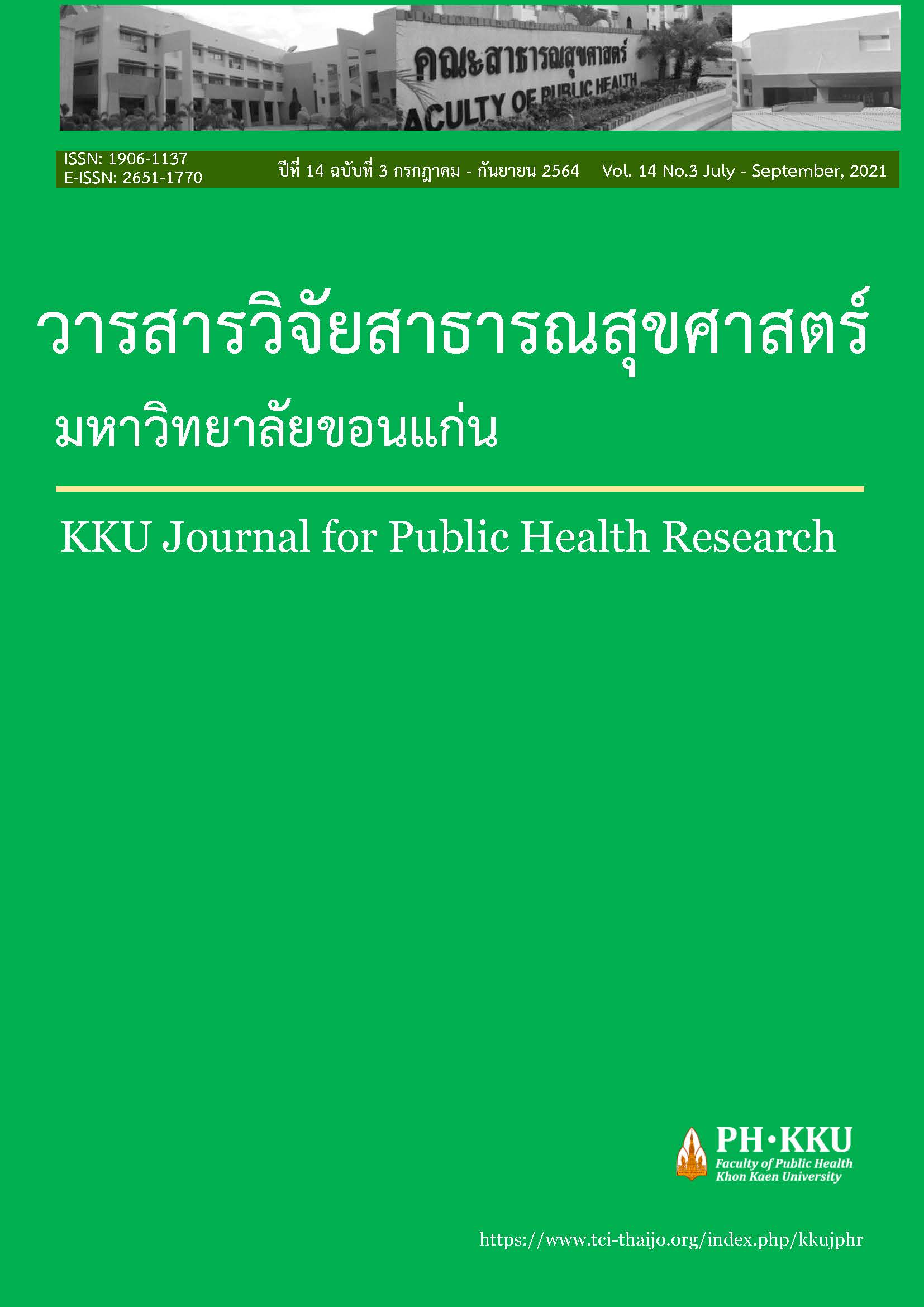การเกิดเข็มทิ่มตำและของมีคมบาดในนักศึกษาพยาบาล
คำสำคัญ:
เข็มทิ่มตำ, ของมีคมบาด, นักศึกษาพยาบาลบทคัดย่อ
การเกิดเข็มทิ่มตำและของมีคมบาดในนักศึกษาพยาบาลพบอุบัติการณ์อยู่ในระดับสูง ซึ่งเป็นประเด็นที่ผู้เกี่ยวข้องต้องตระหนักถึงปัญหา และแสวงหากลยุทธ์ในการป้องกันการเกิดเข็มทิ่มตำและของมีคมบาดดังกล่าว บทความนี้มีวัตถุประสงค์เพื่อทบทวนวรรณกรรมเกี่ยวกับอุบัติการณ์และปัจจัยที่สัมพันธ์กับการเกิดเข็มทิ่มตำและของมีคมบาดในนักศึกษาพยาบาล ในช่วง 10 ปีย้อนหลัง (พ.ศ. 2554 ถึง พ.ศ. 2564) สืบค้นงานวิจัยจากฐานข้อมูล PubMed, Scopus และ ThaiJo โดยใช้คำสำคัญในการค้นหา คือ “เข็มทิ่มตำ”, “ของมีคมบาด” และ “นักศึกษาพยาบาล” ผลการศึกษาพบว่า นักศึกษาพยาบาลมีอุบัติการณ์การเกิดเข็มทิ่มตำและของมีคมบาดตั้งแต่ร้อยละ 1.60 ถึงร้อยละ 91.85 ปัจจัยที่สัมพันธ์กับการเกิดเข็มทิ่มตำและของมีคมบาด ได้แก่ ปัจจัยด้านการทำหัตถการ ปัจจัยด้านนักศึกษา และปัจจัยด้านสิ่งแวดล้อม ดังนั้น สถาบันการศึกษาทางการพยาบาลควรพัฒนาสมรรถนะนักศึกษาพยาบาลในการป้องกันการเกิดเข็มทิ่มตำและของมีคมบาด รวมไปถึงการส่งเสริมความมั่นใจของนักศึกษาพยาบาลในการทำหัตถการทางการพยาบาล ซึ่งจะเป็นปัจจัยที่จะทำให้นักศึกษาเกิดความมั่นใจ และสามารถปฏิบัติการพยาบาลได้อย่างมีประสิทธิภาพ อันจะก่อให้เกิดผลลัพธ์ต่อการบริการทางการพยาบาลที่มีคุณภาพต่อไป
เอกสารอ้างอิง
Alyousef, S. M. (2018). Psychosocial stress factors among mental health nursing students in KSA. Journal of Taibah University Medical Sciences, 14(1), 60-66.
Askarian, M., Malekmakan, L., Memish, Z. A., & Assadian, O. (2012). Prevalence of needle stick injuries among dental, nursing and midwifery students in Shiraz, Iran. GMS Krankenhaushygiene interdisziplinar, 7(1), Doc05-Doc05.
Bagnasco, A., Zanini, M., Catania, G., Watson, R., Hayter, M., Dasso, N., et al. (2020). Predicting needlestick and sharps injuries in nursing students: Development of the SNNIP scale. Nursing Open, 7(5), 1578-1587.
Bektas, I., Bektas, M., Ayar, D., Akdeniz Kudubes, A., Sal, S., et al. (2020). The predict of metacognitive awareness of nursing students on self-confidence and anxiety in clinical decision-making. Perspectives in Psychiatric Care, 57(2), 747-752.
Black-Thomas, L. M. (2020). Nursing faculty experiences with students’ needlestick injuries. Nurse Educator, 45(6), 307-311.
Boonmee, P., Fukfon, K., & Prompao, P. (2013). Incidence of needlestick and sharp injuries and blood and body fluid exposures in nursing students of Boromarajonani College of Nursing, Phayao. Journal of Nursing and Education, 6(2), 124-136.
Cheng, H. C., Su, C. Y., Yen, A. M., & Huang, C. F. (2012). Factors affecting occupational exposure to needlestick and sharps injuries among dentists in Taiwan: a nationwide survey. PLoS One, 7(4), e34911.
Cheung, K., Ching, S. S. Y., Chang, K. K. P., & Ho, S. C. (2012). Prevalence of and risk factors for needlestick and sharps injuries among nursing students in Hong Kong. American Journal of Infection Control, 40(10),
-1001.
Galazzi, A., Rancati, S., & Milos, R. (2014). A survey of accidents during the clinical rotation of students in a nursing degree program. Giornale Italiano Di Medicina Del Lavoro Ed Ergonomia, 36(1), 25-31.
Hada, V., Saurabh, K., Sharma, A., Nag, V., Gadepalli, R., & Maurya, A. (2018). Nursing students: A vulnerable health-care worker for needlesticks injuries in teaching hospitals. Journal of Family Medicine and Primary Care, 7(4), 717-720
Hambridge, K., Nichols, A., & Endacott, R. (2016). The impact of sharps injuries on student nurses: A systematic review. British Journal of Nursing, 25(19), 1064-1071.
Handiyania, H., Kurniawidjajab, L. M., Irawatya, D., & Damayantib, R. (2018). The effective needle stick injury prevention strategies for nursing students in the clinical settings: A literature review. Enfermeria Clinica, 28(1), 167-171.
Huang, H., Yi, Q., Tang, S., & An, R. (2016). Occupational exposure among Chinese nursing students: Current status, risking factors and preventive interventions. International Journal of Clinical and Experimental Medicine, 9(8), 16578-16586.
John, B., & Al-Sawad, M. (2015). Perceived stress in clinical areas and emotional intelligence among baccalaureate nursing students. Journal of the Indian Academy of Applied Psychology, 41(3), 75-84.
Liu, C., Liu, X., Zhu, Y., & Liu, Y. (2015). Influencing factors for needlestick injuries in student nurses. Chinese Journal of Industrial Hygiene and Occupational Diseases, 33(7), 528-531.
Nawafleh, H. A., Abozead, S. E., Momani, M. M. A., & Aaraj, H. (2018). Investigating needle stick injuries: incidence, knowledge and perception among South Jordanian nursing students. Journal of Nursing Education and Practice, 8(4), 59-69.
Ozer, Z. C., & Bektas, H. A. (2012). Needlestick injuries during education period in nursing students in Turkey. Procedia-Social and Behavioral Sciences, 46, 3798-3801.
Panduragan, S. L., Abdullah, N., Hassan, H., & Mat, S. (2011). Level of confidence among nursing students in the clinical setting. Procedia-Social and Behavioral Sciences, 18, 404-407.
Rafati, F., Nouhi, E., Sabzevari, S., & Dehghan-Nayeri, N. (2017). Coping strategies of nursing students for dealing with stress in clinical setting: A qualitative study. Electronic Physician, 9(12), 6120-6128.
Rubbi, I., Cremonini, V., Butuc, A., Cortini, C., Artioli, G., Bonacaro, A., et al. (2018). Incidence and type of health care associated injuries among nursing students: an experience in northern Italy. Acta Bio-Medica, 89(7-s), 41-49.
Silowati, T., Handiyani, H., & Rachmi, S. F. (2019). Prevention behavior for NSI among nursing students and nurses in Indonesia: A comparative study Enfermeria Clinica, 29(Suppl 2), 803–807.
Souza-Borges, F. R., Ribeiro, L. A., & Oliveira, L. C. (2014). Occupational exposures to body fluids and behaviors regarding their prevention and post-exposure among medical and nursing students at a Brazilian public university. Revista do Instituto de Medicina Tropical de Sao Paulo, 56(2), 157-163.
Suliman, M., Al Qadire, M., Alazzam, M., Aloush, S., Alsaraireh, A., & Alsaraireh, F. A. (2018). Students nurses’ knowledge and prevalence of Needle Stick Injury in Jordan. Nurse Education Today, 60, 23-27.
Veronesi, L., Giudice, L., Agodi, A., Arrigoni, C., Baldovin, T., Barchitta, M., et al. (2018). A multicentre study on epidemiology and prevention of needle stick injuries among students of nursing schools. Annali Di Igiene, 30(5), 99-110.
Wu, S. H., Huang, C. C., Huang, S. S., Yang, Y. Y., Liu, C. W., Shulruf, B., et al. (2020). Effect of virtual reality training to decreases rates of needle stick/sharp injuries in new-coming medical and nursing interns in Taiwan. Journal of Educational Evaluation for Health Professions, 17, 1.
Yao, W. X., Wu, Y. L., Yang, B., Zhang, L. Y., Yao, C., Huang, C. H., & Qian, Y. R. (2013). Occupational safety training and education for needlestick injuries among nursing students in China: intervention study. Nurse Education Today, 33(8), 834-837.
Zhang, X., Chen, Y., Li, Y., Hu, J., Zhang, C., Li, Z., et al. (2018). Needlestick and sharps injuries among nursing students in Nanjing, China. Workplace Health and Safety, 66(6), 276-284.
ดาวน์โหลด
เผยแพร่แล้ว
รูปแบบการอ้างอิง
ฉบับ
ประเภทบทความ
สัญญาอนุญาต
ลิขสิทธิ์ (c) 2021 คณะสาธารณสุขศาสตร์ มหาวิทยาลัยขอนแก่น

อนุญาตภายใต้เงื่อนไข Creative Commons Attribution-NonCommercial-NoDerivatives 4.0 International License.



